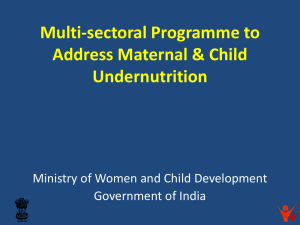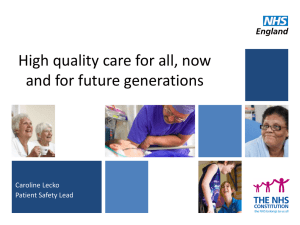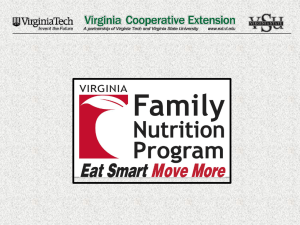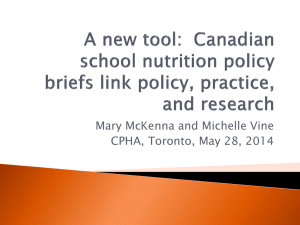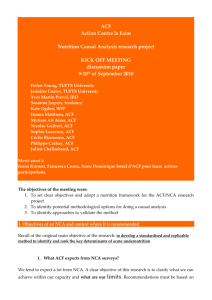REACH_Nutrition Advocacy Strategy
advertisement
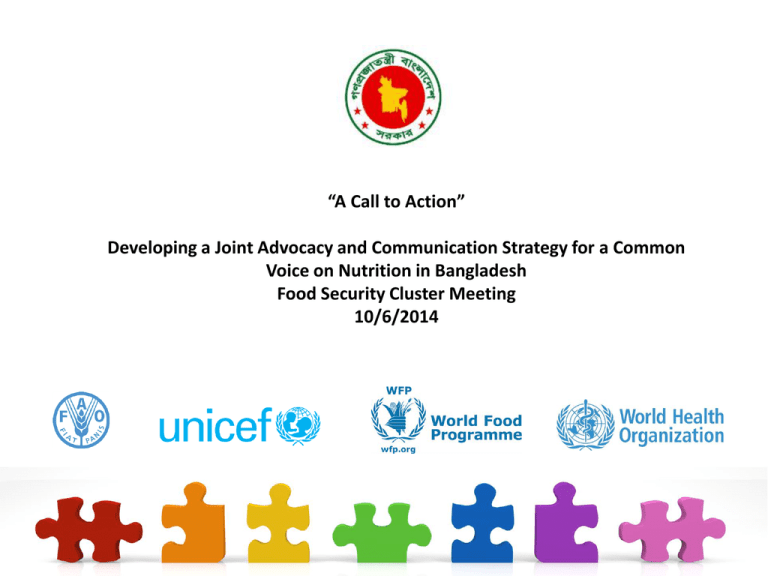
“A Call to Action” Developing a Joint Advocacy and Communication Strategy for a Common Voice on Nutrition in Bangladesh Food Security Cluster Meeting 10/6/2014 Initial review of nutrition focused advocacy and communications • • • • • • Well executed and strategic approaches to nutrition advocacy (IPHN, Alive & Thrive, Fanta/FHI360, Eminence, World Vision, Save the Children, UNICEF, BBF, BRAC etc.) Strong examples of planned BCC work (National Communications Framework and Plan for IYCF) Messages are diluted, unfocused and challenging to action for policy makers Nutrition language can be technical and does not connect – speaks to mind not to heart A focus on negative communication has characterized much past communication – shift toward aspirational Media reporting has largely been only event and statistics based – “Not a hot issue” (Prothom Alo) – with exception of concerted efforts under media capacity building programs. A more coherent nutrition agenda is required which builds on the separate efforts related to micronutrient deficiencies, breastfeeding promotion, complementary feeding and others. The interconnected causes of undernutrition Lack of good Insufficient access to affordable, nutritious CARE FOOD for mothers and children and support for mothers on appropriate child feeding practices throughout the year Inadequate access to HEALTH sanitation and clean water services ROOTED IN Political and cultural Environment Poverty Disempowerment of women A joint Advocacy and Communication Strategy on improving nutrition in Bangladesh can help: Create awareness amongst decision makers that nutrition is a multisectoral issue Identify and support nutrition champions Create a coherent push for raising mass public awareness of child and maternal nutrition, with renewed emphasis on the critical 1000 day window from conception to age two Create an enabling environment for supporting multisectoral leadership and stakeholder collaboration. Overview • The final output will align with all ongoing Government policies and plans and is being led by the Ministry of Health and Family Welfare in close collaboration with the Ministry of Food • It will support the Scaling-up Nutrition (SUN) movement in Bangladesh by contributing to its visibility and helping to develop an enabling environment for Government leadership. • Developed with UN, donors, civil society, academics, youth and media and strengthening effective nutrition coalitions What is required In order to catalyze change leading to continued improvements in nutrition a mix of three key complimentary approaches are needed: 1. 2. 3. Advocacy to help garner political support Communication for social change for engaging and motivating different communities and networks for a more enabling environment Behavior change communication to help inform, influence and support individuals, families, community groups and opinion leaders. Phases of the strategy development 1. Identify the problems 2. Identify the issues that advocacy and communication can address 3. Set objectives 4. Identify the audiences and their information needs 5. Develop advocacy messages for the different audiences 6. Communicate the advocacy messages (include the production of relevant materials and tools and training the different groups) 7. Follow up and monitor Goal Vision The people of Bangladesh will lead a healthy life based on optimum nutrition To stimulate a national multisectoral and multistakeholder effort to reduce the prevalence of undernutrition with a particular focus on mothers, children and adolescent girls. Objectives… Coordination Political Will Communication & Education Behaviour Change Audiences and their information needs Primary – those most affected by undernutrition • E.G. Children under 5 years, Pregnant and lactating women, adolescents… Secondary – those directly influencing populations most affected by undernutrition • Husbands, peers, leaders, teachers… Tertiary – those indirectly influencing populations most affected by undernutrition • Media, Parliamentarians, Local government, Civil society, Private sector, Ministries Issues to be emphasized • Combat beliefs and practices by highlighting proven nutrition interventions and appropriate, food, health and care behaviours. • Highlight damage to brain function • Involve male family decision makers • Involve older women and mothers-in-law • Ending child marriage • Highlight the economic reasons for investing in nutrition for national decision makers • Communicate the multisectoral approach in a manner which all sectors can understand and action. Initial Activities to be developed Coordination Multisectoral nutrition workshops, harmonized messages for inter-ministerial coordination Political Will Multisectoral policy briefs for all key Ministries, key meetings, opinion piece campaign, high level meetings with visual aids, champions, exchange visits, participatory video Communication & Education Continued journalist and media gatekeeper capacity building, school curriculum influencing, social media campaign, targeted- aspirational messages on nutrition for key target audiences, catalyze private sector dialogue, revitalization of key IYCF resources Behaviour Change Focus on best practice, support harmonization of materials, strengthen links to child marriage Channels for communication mass media interactive popular theatre mobile phones community radio youth groups peer to peer communication education and call to action materials school curriculum high level workshops policy briefs evidence from other countries identify supportive champions social media campaigns, TVCs influencing political party manifestos… Common Narrative on Undernutrition Participatory Video - Satkhira • • • • • Women’ status Child Marriage IYCF Complementary Feeding Food Security





